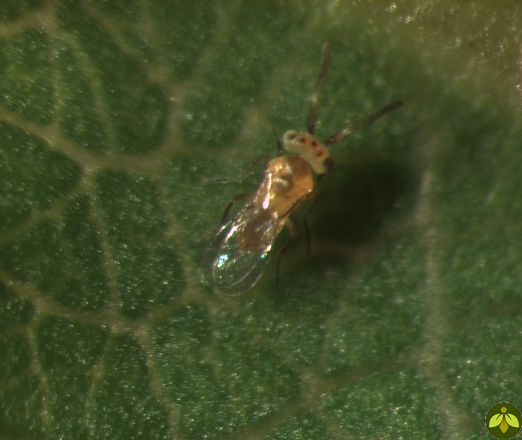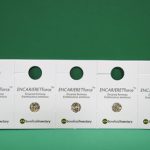Description

Control whitefly populations with Eretmocerus eremicus, a whitefly parasite used for the prevention and low-infestation management of Bemisia spp. whiteflies. These 0.8 mm. mini-wasps are best used for preventing the establishment of the silverleaf and sweet potato whitefly (the Bemisia spp., B. argentifolii and B. tabaci, respectively). They can also tackle minor to medium infestations. And, if established to a degree, they can adequately protect a crop throughout the season. (If you have greenhouse whitefly, Trialeurodes vaporariorum, use Encarsia formosa). Eretmocerus eremicus are supplied as pupae protected in their host whitefly scales (pupae). These parasitized scales are sometimes supplied loose in a bottle with bran flakes which can be distributed throughout the crop, plain without the bran, and in blister-pack hanging cards.
Lifestyle
Whitefly predators, as parasitoids, work by laying eggs. But unlike E. formosa, which lay their eggs in the 2nd through 4th immature whitefly stages, Eretmocerus eremicus females lay their eggs underneath those same stages, with a preference for the 2nd instar (stage). The wasps’ larvae which hatch from the eggs begin to enter the host and thus slowly weaken and kill the developing whiteflies from the outside-in (ectoparasitism). This causes noticeable host changes (see Scouting). And each female wasp (which equals 50–65% of the total release) can do this to up to 150 immature whiteflies! The lifespan of these parasitoids is roughly 18 days in their immature stages, then for a currently undetermined period of time as yellow-colored adults. The conditions for optimum performance will be between 70–95°F with a relative humidity of 60% or less. These are optimum conditions and not necessarily essential for successful implementation. Please note that considerably cooler temperatures will hamper reproduction and development a certain degree while higher temperatures don’t seem to critically impact the whitefly control performance (see Benefits, next).
Benefits
These parasitoids, being native to America’s desert region, can handle high daytime temperatures, supposedly up to 113°F, as well as cold nighttime temps. These wasps are easily noticed when developing — though not as much so as E. formosa — making scouting a little easier (see Scouting). Host-feeding activity runs high with this species and it’s more than an added bonus; these parasitoids could almost be regarded as predators. Bottom line: they’re a great, effective whitefly treatment.
Scouting
The scales, when parasitized, begin to reveal the developing wasps inside. Like it is with E. formosa, the whitefly pupa darkens as the parasitoid within develops, a darkening gold in this case, and not as much so as to conceal the larval wasp. It may be seen in the right conditions and at the right time. Yellow sticky traps might not be able to be used at times (see Advisories, next).
Advisories
Yellow sticky traps might have to be removed prior to releasing these mini-wasps, but you should definitely closely observe the traps if they remain in use. If you need to monitor for thrips, try using blue traps. If yellow traps must be used for fungus gnats, etc., you might need to hang them for only two days per week. To reduce adult whitefly levels, fast, instead of placing about a million sticky traps up Suck ‘em up!Ants, if present, should probably be controlled. They will defend whiteflies from predators and parasites to protect their honeydew food (the excrement of whiteflies, ick!). Use barrier products or boric acid products to control the ants. If your plant area doesn’t have any ants, check to be sure that the honeydew isn’t too heavy. This may make whitefly control more difficult and the mini-wasps may spend too much time cleaning themselves. Washing the plants with soap and water — at the highest possible pressure — may help reduce the amount of honeydew. Some crops, due to their excessive whitefly susceptibility, may require special IPM attention for whitefly treatment, higher release rates and/or more frequently scheduled releases (closer intervals).
Usages
Control whiteflies using these mini wasps on most greenhouse crops and interior situations.
Release rates
Apply at 0.5-20 parasites per 10 square ft depending on whitefly occurrence and intensity. Use at low doses to prevent whitefly establishment. Use a selective insecticide to clean up existing populations.
Produced in the USA by Beneficial Insectary!
Purchase
-

ENCAR/ERETforce™ – whitefly parasite mix 100 per card (5,000/ 10,000/ 15,000)
$107.95 – $159.95 Select options This product has multiple variants. The options may be chosen on the product page -

ERETforce™ whitefly parasite 100 per card (5,000/ 10,000/ 15,000)
$62.95 – $179.95 Select options This product has multiple variants. The options may be chosen on the product page
